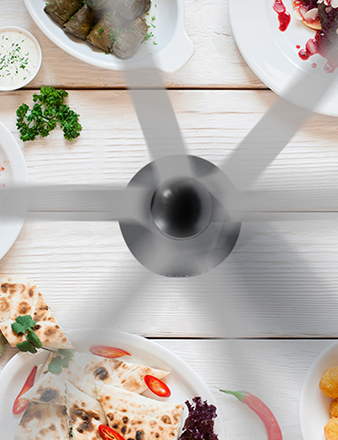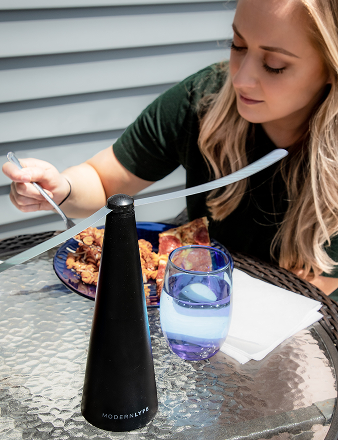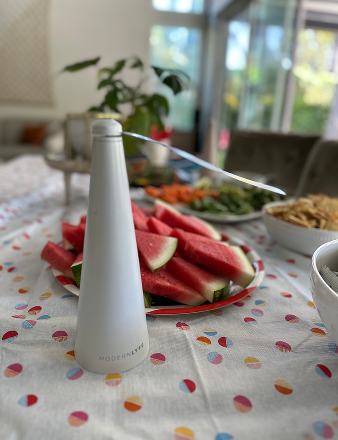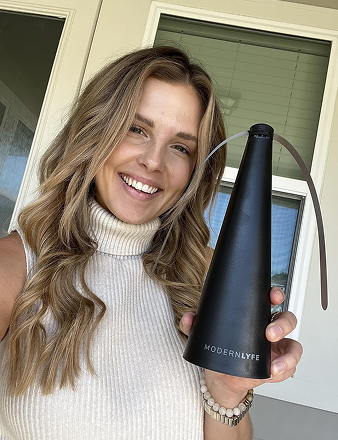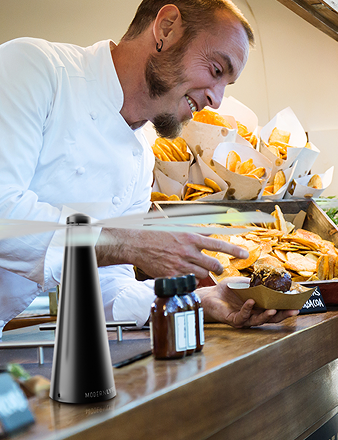A commercial fly fan is also known as an air curtain or air door. It creates a powerful, invisible wall of air over an entryway to block flying insects. This chemical-free pest control solution uses simple physics—most flies can’t push through the high-velocity airflow—making it a perfect choice for businesses.
Why Your Business Needs a Commercial Fly Fan
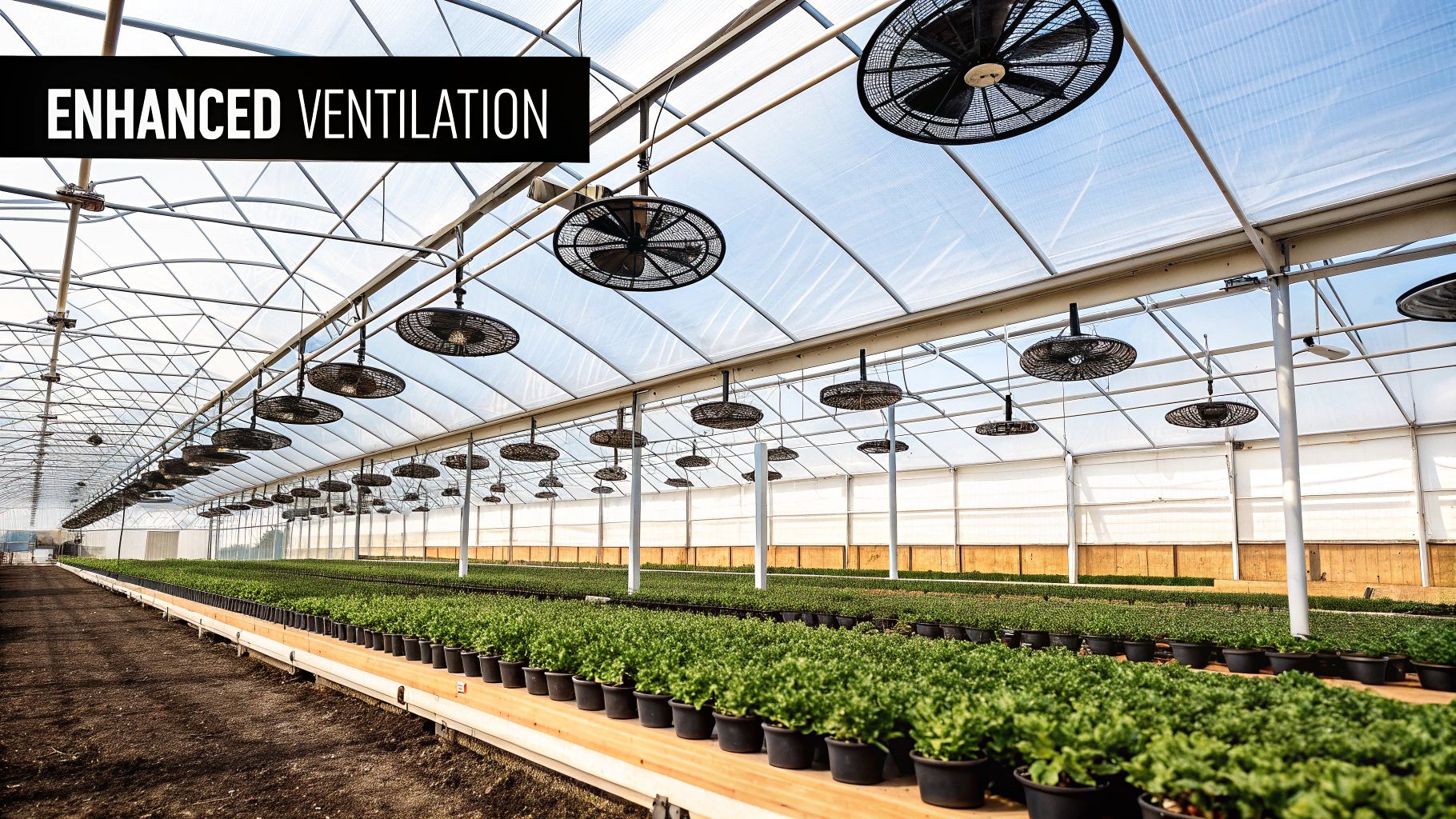
Sprays and sticky traps are outdated for a busy commercial space. They look unprofessional, require constant maintenance, and introduce chemicals where you prepare food or serve customers. A commercial fly fan is a superior, always-on solution that avoids all these issues.
Its effectiveness lies in its simplicity. By creating a steady, forceful air barrier, the fan physically stops pests from entering every time the door opens. This is a game-changer for high-traffic areas like a restaurant patio or a warehouse loading dock.
Protect Your Reputation and Bottom Line
For any public-facing business, a single fly can ruin a customer's experience and lead to negative online reviews. An air door is a simple fix. For example, a busy urban cafe nearly eliminated pest complaints overnight by installing an air door at its main entrance, directly improving its online ratings and customer satisfaction.
Beyond perception, sanitation is non-negotiable. Flies can carry over 100 different pathogens, posing a serious health risk. A fly problem can quickly lead to a failed health inspection. Understanding common restaurant health code violations highlights just how critical pest control is.
Proactive pest management isn't just about appearances. It's a core part of running a safe, sanitary, and compliant business that protects your customers, team, and brand.
A Smart Investment for Any Commercial Space
Think of a fly fan as essential equipment, not an accessory. In a comprehensive commercial kitchen equipment list, an air curtain is as important as ovens and refrigerators. Its value extends across various industries:
- Restaurants and Cafes: Keeps dining areas and kitchens free from airborne pests, which is crucial for food safety and guest experience.
- Warehouses and Distribution Centers: Secures loading docks from insects without obstructing the flow of people and products.
- Healthcare Facilities: Helps maintain sterile environments by blocking insects from entering clean areas.
- Retail Stores: Improves the shopping experience, especially for stores with open-front layouts.
Ultimately, a commercial fly fan isn't an expense; it's an investment that pays for itself through better sanitation, happier customers, and smoother operations.
Comparing Different Types of Commercial Fly Fans
Choosing the right commercial fly fan requires understanding the key differences between models. The fan for a quiet café entrance is useless at a busy warehouse loading dock. To make a smart investment, you need to know your options.
The first major decision is between a heated or unheated unit.
Unheated fans, or ambient models, are the most common and budget-friendly choice. They push out a curtain of room-temperature air, making them ideal for most indoor applications and climates where a winter chill isn't a concern.
Heated models include a built-in heating element, which increases the price and energy use. However, they are essential for businesses in cold climates. A heated model prevents a blast of cold air from hitting customers in winter, keeping them comfortable and preventing your HVAC system from working overtime.
Low-Profile vs. Industrial Designs
Beyond heating, the fan's physical design—its shape, size, and power—determines its proper application. The two primary styles are low-profile and industrial.
Low-Profile Models are designed for customer-facing areas like restaurants, retail shops, and lobbies.
- They are sleek, compact, and designed to blend in with your decor.
- These units operate quietly to avoid disrupting conversations.
- They are built for standard door heights, typically in the 7-10 foot range.
Industrial Models are built for performance, not aesthetics.
- Constructed from rugged materials like stainless steel, they withstand tough environments like warehouses and commercial kitchens.
- They feature powerful motors that create an effective air barrier over openings 12 feet or higher.
- Their larger size and weight often require a more involved installation with heavy-duty mounting.
This infographic breaks down the core benefits of installing the right commercial fly fan for your space.
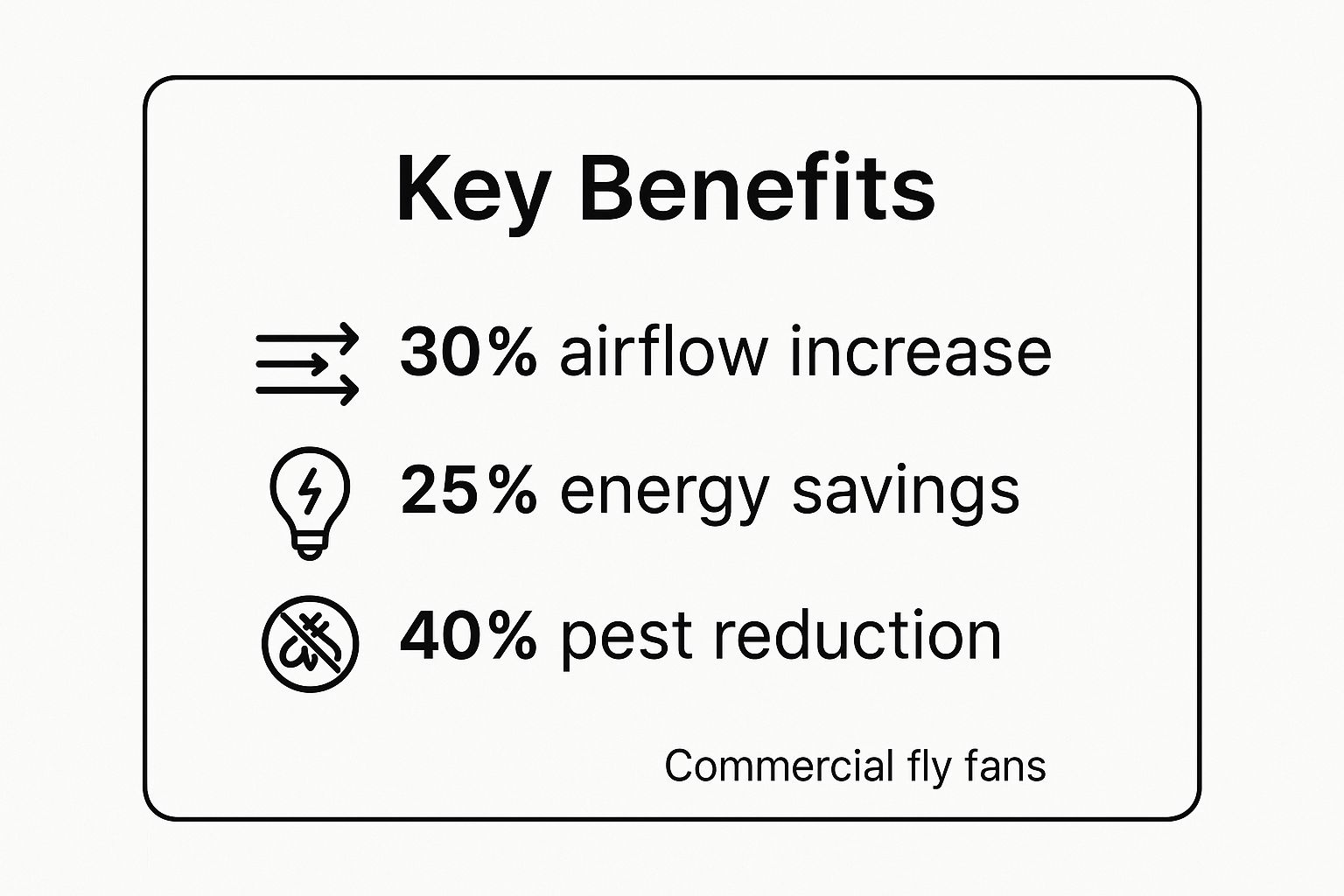
These fans do more than stop flies; they provide real operational benefits, from pest control to energy savings.
Making the Right Choice for Your Space
This quick comparison table helps you narrow down the best fan type for your specific installation.
Commercial Fly Fan Feature Comparison
| Fan Type | Best For | Key Features | Typical Cost Range |
|---|---|---|---|
| Low-Profile (Ambient) | Customer-facing areas like retail stores, cafés, and office entrances in moderate climates. | Sleek design, quiet operation, easy installation, designed for standard 7-10 ft. doors. | $300 - $900 |
| Low-Profile (Heated) | Customer entrances in colder climates where maintaining indoor temperature is crucial. | Aesthetically pleasing, provides a warm air curtain, prevents drafts and heat loss. | $800 - $2,000+ |
| Industrial (Ambient) | Warehouses, loading docks, manufacturing facilities, and back-of-house areas with large openings. | Heavy-duty construction, powerful motors for high-velocity air, designed for doors 12 ft. and up. | $700 - $2,500 |
| Industrial (Heated) | Large, high-traffic commercial or industrial doorways in cold environments, like distribution centers. | Maximum power and durability, provides powerful heating to offset significant heat loss. | $1,500 - $5,000+ |
It all comes down to matching the fan to your doorway and needs. An industrial fan over a small boutique door is overkill. A low-profile fan on a 14-foot warehouse bay won't work.
Pro Tip: Before you shop, measure your doorway. The fan must be at least as wide as the opening. If it's too short, you'll have gaps on the sides where pests can enter, defeating the purpose of your investment.
Key Specs to Look for When Choosing a Fly Fan
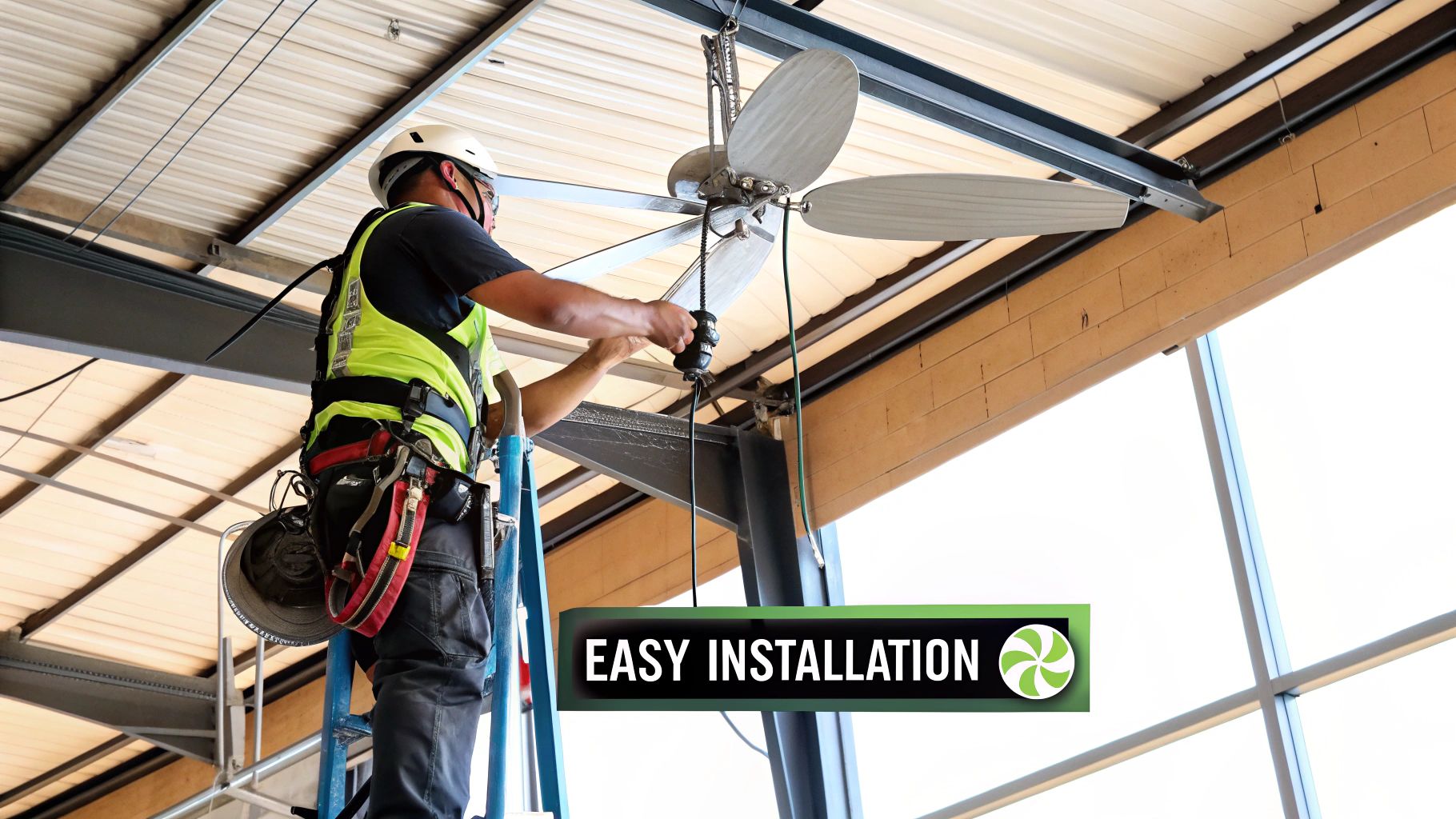
Once you've chosen the right type of fly fan, focus on the technical specs. These details determine whether a fan actually keeps flies out or just becomes expensive background noise.
The two most critical metrics are CFM (Cubic Feet per Minute) and FPM (Feet per Minute). Together, they define a fan's power and effectiveness.
Understanding Airflow and Velocity
CFM measures the volume of air the fan moves per minute. It represents how much air is being pushed down to create the invisible barrier.
FPM measures the speed of that air. This is the velocity needed to physically stop a fly. For effective pest control, the airstream should hit at least 1,500 FPM about three feet from the floor.
These two specs work together. A fan with high CFM but low FPM moves a lot of air slowly—a gentle breeze, not a barrier. You need both sufficient volume (CFM) and speed (FPM) to create an impenetrable air curtain from top to bottom.
Matching Fan Power to Your Space
The right CFM and FPM ratings depend on your specific doorway and environment.
- Door Size: Taller and wider doors require more powerful fans with higher CFM to ensure complete coverage without weak spots.
- Wind Conditions: If your entrance is exposed to strong winds, you need a fan with higher FPM to counteract the external pressure. Otherwise, the air curtain will be blown back inside.
Buying an underpowered fan to save money upfront is a costly mistake. A warehouse that installed a cheap model on its main loading dock found that afternoon drafts rendered it useless. They had to replace it a year later, effectively doubling their cost.
Don't let the initial price be your only guide. An underpowered commercial fly fan is a wasted investment. Pay for the right power upfront to solve the problem correctly the first time.
Beyond Power: Durability, Noise, and Efficiency
Three other factors determine a fan's long-term value.
- Motor Durability: The motor is the heart of the unit. Look for high-quality motors built for continuous commercial use, especially in high-traffic areas.
- Noise Levels (dBA): For customer-facing areas, noise is a major consideration. A loud fan can ruin the ambiance. Check the decibel (dBA) rating—the lower the number, the quieter the fan.
- Energy Efficiency: A powerful fan doesn't have to be an energy hog. Modern units are designed for efficiency, leading to significant savings on operating costs. This focus on sustainability is why the global industrial and commercial fan and blower market trends show a projected growth from $8.7 billion in 2023 to $18.3 billion by 2034.
Finding the right balance of power, quiet operation, and efficiency is key to a smart investment.
Nailing the Installation for Maximum Impact
A top-of-the-line commercial fly fan is only as good as its installation. A poor setup wastes money and won't create the effective air barrier you need. Getting the installation right is critical to solving your fly problem.
The goal is to create a solid, unbroken curtain of air that seals the doorway. Any gaps become entry points for pests. This starts with perfect placement.
Placement and Mounting: The Make-or-Break Details
Mount your fly fan as close to the top of the doorframe as possible. If it's mounted too high, the air loses velocity, creating a weak spot at the top where flies can get through. The unit should be snug and tightly against the header with no gaps.
Width is equally important. The fan must be at least as wide as your door, but an inch or two wider on each side is even better. A narrow fan leaves gaps on the sides, creating an open invitation for pests.
Pro Tip: Angle the airstream slightly outward by about 15-20 degrees. This small adjustment actively pushes insects away and helps counteract incoming drafts that could suck them inside.
Proper Electrical and Safety Procedures
Correct wiring is about safety and longevity, not just function. Always verify the manufacturer's specs for voltage and amperage. Incorrect wiring can damage the motor or become a fire hazard.
Keep these electrical points in mind:
- Dedicated Circuit: Heavy-duty industrial or heated models draw significant power and almost always require a dedicated circuit to avoid tripping breakers.
- Door Switches: Connecting the fan to a door-activated switch (like a plunger switch) is a smart energy-saving move. The fan runs only when the door is open, slashing energy costs.
- Hire a Pro: If you're not 100% confident with electrical work, hire a licensed electrician. It's a small price for peace of mind. This is especially true for complex installations tied into other building systems, like commercial kitchen ventilation systems.
Getting these details right ensures your commercial fly fan operates safely and effectively for years.
Simple Maintenance for Long-Term Performance
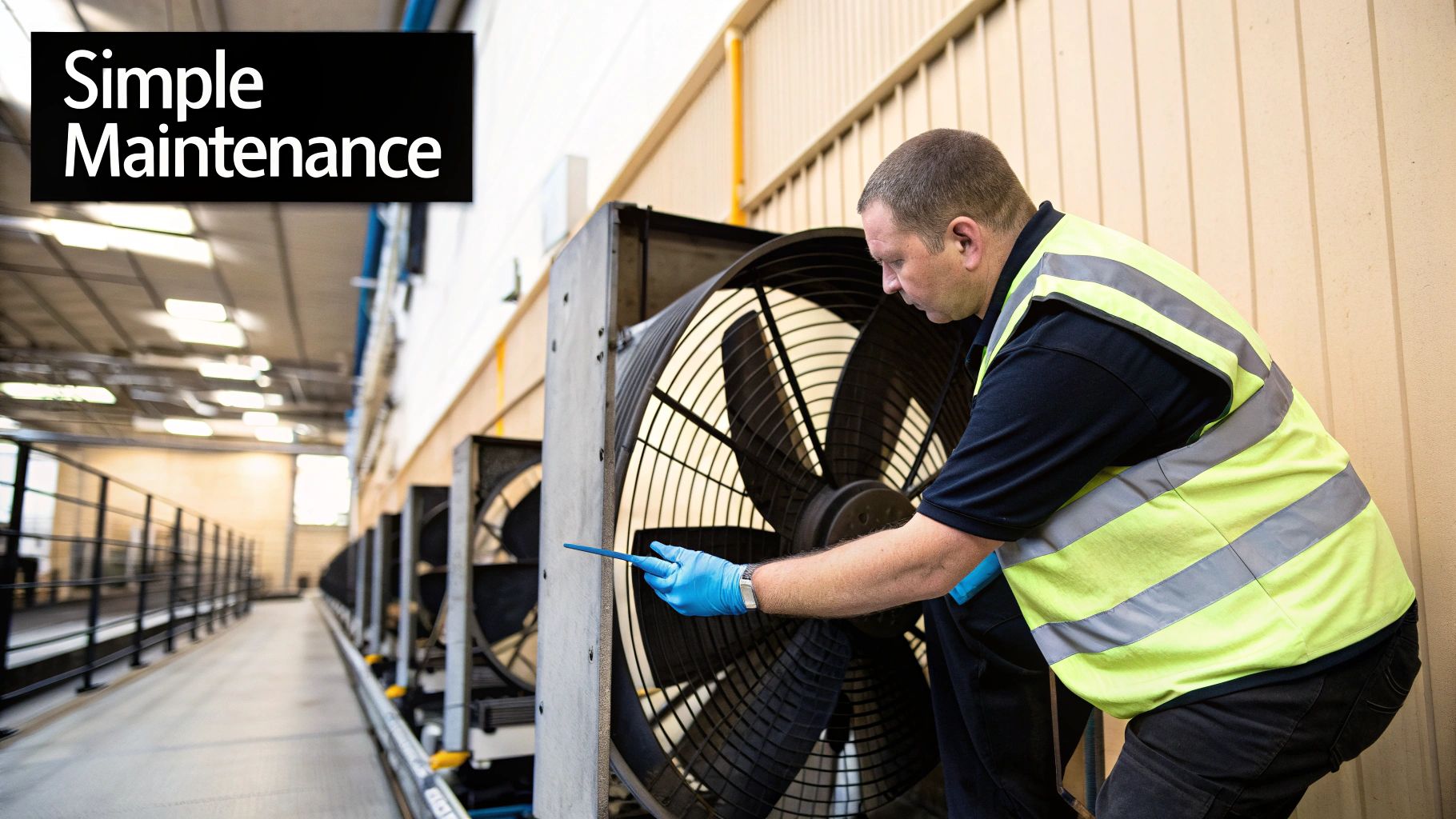
Your commercial fly fan is built to last, but routine care guarantees its performance and reliability. Over time, dust and grime build up, restricting airflow and forcing the motor to work harder, which reduces the fan's effectiveness.
The good news is that maintenance is simple. For most locations, a quick monthly cleaning is sufficient. However, in tougher environments like a busy kitchen or a dusty warehouse, clean it every few weeks.
Your Go-To Cleaning Checklist
First and most importantly: always disconnect the power at the circuit breaker before you begin. Safety is the top priority. Once the unit is powered down, follow these steps.
- Wipe Down the Housing: Use a damp cloth to wipe down the exterior. This prevents dust from accumulating and being pulled into the motor.
- Clear the Intake Grill: This area collects the most debris. Use a soft brush or a vacuum with a brush attachment to clear away dust and lint.
- Clean the Blades: Gently wipe each fan blade with a damp cloth. Clean blades move air more efficiently and reduce strain on the motor.
Regular cleaning also improves indoor air quality, a growing priority for businesses. The market for commercial air quality solutions reflects this, with a projected value of USD 162 billion by 2032, up from USD 71.1 billion in 2022.
Performing Quick Mechanical Checks
Beyond cleaning, a brief monthly mechanical inspection can help you catch small problems before they become costly repairs.
Start by checking the mounting hardware. Ensure all bolts and screws are tight and the unit is securely attached. Vibrations can cause hardware to loosen over time.
Next, listen to the fan. If you hear any new rattling, grinding, or whining sounds, it could signal a bad bearing or a loose part that needs immediate attention.
Pro Tip: If your fan is connected to a door-activated switch, test it regularly. Open and close the door a few times to ensure the fan turns on and off correctly. A faulty switch can leave you unprotected or waste electricity.
This proactive approach protects your investment. Even the most durable commercial equipment benefits from consistent upkeep. To explore other options, check out our guide on the fly repellent fan.
Got Questions About Fly Fans? We've Got Answers.
Even with all the details, you might still have a few questions. Let's cover some of the most common inquiries from business owners to help you make a confident decision.
Are These Things Expensive to Run?
It's a valid concern. You see a powerful fan and think of the electricity bill. The good news is that modern commercial fly fans are surprisingly energy-efficient.
While there's an upfront cost, the daily operating expense is minimal compared to recurring pest control services or disposable traps.
An unheated ambient model consumes about the same power as a standard industrial fan. To maximize efficiency, choose a model compatible with an automatic door switch. This ensures the fan only runs when the door is open, significantly cutting down on energy waste.
Just How Loud Are They?
No one wants a fan that sounds like a jet engine, especially in a restaurant or boutique where ambiance is key. The noise level, measured in decibels (dBA), depends on the fan type.
- Low-profile units for customer entrances are designed for quiet operation, working effectively without being noticed.
- Heavy-duty industrial models for loading docks are louder, but in those environments, the extra noise is rarely an issue.
Always check the dBA rating on the spec sheet before buying. It's the best indicator of sound output and will help you choose a fan that fits your space without disturbing customers or staff.
Can I Use a Fly Fan Instead of AC?
This is a common misconception. The short answer is no; a fly fan is not a replacement for an air conditioner.
Its primary job is to create an air barrier to keep bugs out and prevent your heated or cooled air from escaping. It does not cool the air.
While the strong breeze can feel refreshing, think of the fan as a partner to your HVAC system, not a substitute. It boosts your system's efficiency by keeping conditioned air inside. It's easy to see why the growing ventilation fan market on Grand View Research is booming, with a valuation of USD 3.57 billion in 2024.
Ready to create a bug-free zone with a quiet, effective solution? Take a look at the stylish and powerful fly fans from MODERN LYFE to find the perfect match for your business. Check us out at https://modernlyfe.com and see how we can help upgrade your space.

